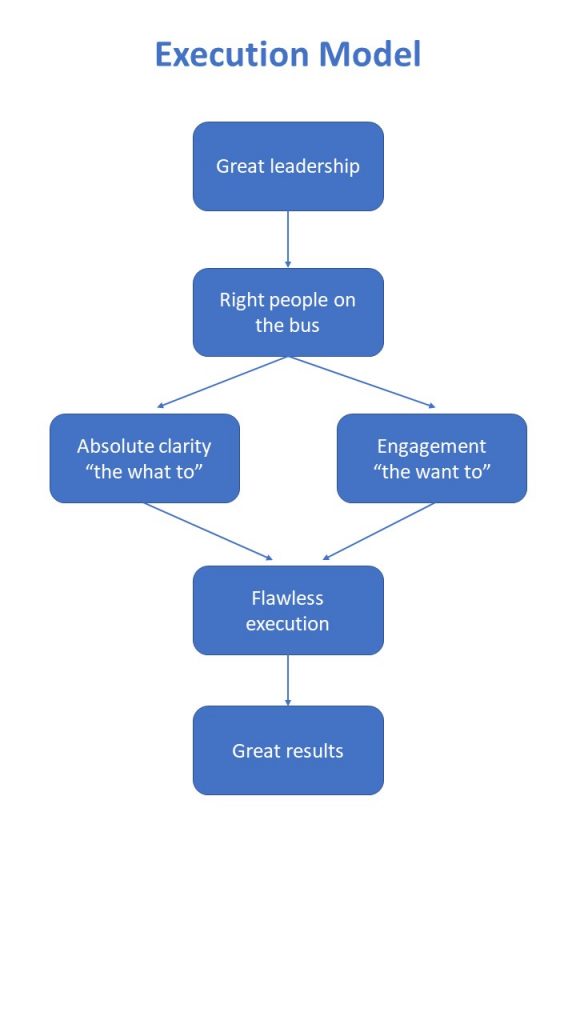Absolute clarity
Reflections:
As we explored last week, leaders at every level have a critical role to play in executing. Execution means no more than getting the job done, whether it’s day to day activities or building a better tomorrow by delivering a longer term vision.
Thirdly we need clear goals or objectives for what we are there to achieve. These need to be measurable and regularly reviewed to confirm progress and continued relevance
Finally we need support from our boss at regular, structured, effective 1-1s (read more on 1-1’s below)
Where all those four elements are in place people thrive. They have enough clarity and support to focus on the most important things, and to execute effectively.

“Power of 3” ground rules
How does Mary enable her people to focus on just three highest priorities at any one time? By setting a few “Power of 3” ground rules, as follows:
- The three goals should account for around 70% of activity in any given week. In other words 70% of a persons time should be focussed on delivering those three goals. Much more than 70% is unrealistic – there is always other stuff to do. Much less than 70% suggests these three are not the most truly important things.
- The trick is to get them at just the right level. Too broad and they lack focus and clarity, too detailed and it is unlikely that there will be only three.
- Each goal will contain detail below it of how to make it happen, how to execute the goal. Of course the devil is in the detail, but at this level they cannot contain every piece of it.
- Each goal must be measurable and regularly reviewed and measured.
- In some roles, goals will be long-term and the focus will be on breaking them down into manageable chunks. In other roles the goals may actually change regularly.
Mary understands that her role is to enable her people to deliver their goals. She ensures they have the clarity but are given the freedom to deliver. She holds regular reviews to monitor progress and support delivery…
When this works effectively, it can make monitoring someone’s performance so easy. It provides a real focus for one to one’s but can also be built simply and elegantly into performance management systems and appraisals.
1-1’s
I cannot stress too highly how crucial it is for leaders to hold regular 1-1’s with their people. I think there is no more important a session. Too often, I come across managers who have the best of intentions for holding these sessions but all too frequently cancel them, because other urgent things get in the way. Always urgent things – often not important things.
Another barrier I hear frequently is managers are too busy to have time to hold regular 1-1’s. I accept people are really busy these days – it’s a word I hear time and time again, but never confuse business with effectiveness. They are very different things. Indeed, this busy-ness is often a result of not having regular 1-1’s.
I am often told that a manager has too many direct reports to be able to hold 1-1’s. If they have ten or more direct reports, I agree with them. The problem here is not the 1-1’s, it’s the number of direct reports and although it might be tough to find solutions, its the structure that needs addressing.
Doubters also say they are not necessary because they see their people informally on a daily basis. That’s great and long may it continue – informal catch ups are important, but never let them detract from holding a regular formal session.
I understand its more challenging if your team is based remotely. So, make it happen – virtually if necessary, although face to face contact is still very important when possible.
The frequency and duration of 1-1’s will vary according to need, but as a guide I believe once a month for an hour is about right. They should also be personalised to the needs of the individual, but can follow a basic agenda:
- How has the team member performed against their “power of 3” goals since the last 1-1?
- What are the areas of focus before the next 1-1?
- What does the leader need to do to enable the team member to deliver successfully?
Top and tail the session with a personal catch up (for which you need a genuine desire to get to know the whole person) and you have the perfect 1-1 framework.
There are lots of places it’s possible to hold 1-1’s, often it’s really good to get out of the office. Holding a 1-1 in the office may be most time efficient, but a change of environment can really work very well.
1-1’s are just one part of great performance management. They provide an opportunity, on a regular basis, to review performance, but are supplemented by frequent informal contact, and by some kind of appraisal process.
